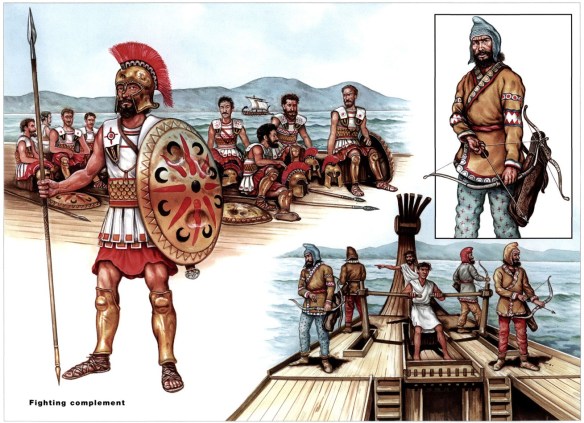The epibates (left) is a citizen-hoplite in his early twenties. His panoply (panoplia), weighing anywhere from 22.7 to 31.7kg (50-70lb), consists of a shield (aspis) some 90cm (35 1/2in.) in diameter, a bronze helmet, a bronze or linen corselet and bronze greaves.
Built on a wooden core, the shield is faced with a thin layer of stressed bronze and backed by leather. Because of its great weight, (6.8-9.1 kg or 15-20lb), the shield was carried by an arrangement of two handles; the armband (porpax) in the centre through which the forearm passed, and the handgrip (antilabe) at the rim. Held across the chest, it covered the hoplite from chin to knee. However, being clamped to the left arm, it only offered protection to his left-hand side.
Above the flat, broad rim of the shield, a hoplite’s head was fully protected by a bronze helmet, the Corinthian helmet being by far the most common style. This was fashioned from a single sheet of bronze that covered the entire face, leaving only the eyes clear. The stress on protection seriously impaired both hearing and vision, so out of battle it could be pushed to the back of the head to leave the face uncovered.
A linen corselet (linothorax) protected the torso. This was built up of multiple layers of linen glued together to form a stiff shirt, about half a centimetre thick. Below the waist it was cut into strips (pteruges) for ease of movement, with a second layer of pteruges being fixed behind the first, thereby covering the gaps between them. Finally, a pair of bronze greaves (knemides) protected the lower legs, which clipped neatly round the calves, held by their own flexibility.
The weapon par excellence of the hoplite was the long-thrusting spear (doru); some 2 to 2.5m in length (7-9ft), made of ash and equipped with a bronze or iron spearhead and bronze butt-spike, affectionately known as the ‘lizard-sticker’ (sauroter). A short iron sword (kopis) was also carried, along with a heavy, leaf-shaped blade designed for slashing, but this was very much a secondary weapon.
The Scythian toxotes (inset), a steppe-dweller from north of the Black Sea and recruited as a mercenary, is gaily clothed in a patterned, loose-fitting tunic with sleeves and trousers, and wears a soft cap of leather. He is armed with a composite bow, a dagger and the sagaris, or battle-axe. His gorytos, or bow-case is ornamented with painted patterns and contains a spare bow and supply of arrows. He uses the Mediterranean release, whereby the bowstring is drawn back to the chin or chest by the tips of three fingers, with the arrow lightly held like a cigarette, if held at all, between the first and second fingers. The fourth finger and thumb are not used. This technique required the use of a leather bracer on the left forearm, the bow being held in the left hand, to protect it from the backlash of the bowstring. Leather ‘shooting tabs’ to protect the archer’s fingers from the bowstring were also employed. Scythians had a reputation as formidable archers and, by all accounts, they deserved it.
